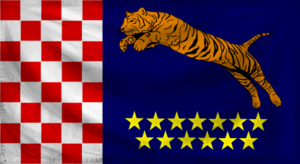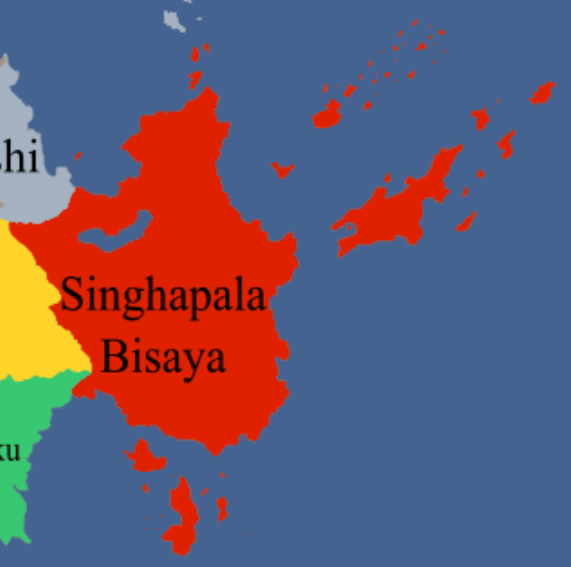Singhapala Bisaya
Singahapala Bisaya Republic Konhagok sa Singhapala Bisaya | |
|---|---|
|
Flag | |
| Motto: "Dem Tuhan – Katawhan – Katagbo" (Cebuano) "For God – People – Prosperity" | |
| Anthem: "Martsa Sunhavit (Cebuano)" Sunhavit's March a | |
| Capital | Fort Sotto |
| Largest city | Fort Opon |
| Official languages |
|
| Ethnic groups |
|
| Demonym(s) | (Singhapala) Bisaya |
| Government | Federal presidential constitutional republic under a one-party technical regime |
• President | Severus Cehideran Billings |
• Vice President | Simon Kanbatag Panbaliao |
| Legislature | National Congress |
| Independence from Chola Bisaya Empire | |
• Declared | 25 December 1871 |
• Current Constitution | 1 October 1966 |
| Area | |
• Total | 975,442 km2 (376,620 sq mi) |
• Water (%) | 3.0 |
| Population | |
• May 2024 estimate | 295,844,375 (1st) |
• 2020 census | 281,742,775 |
• Density | 302.57/km2 (783.7/sq mi) |
| GDP (PPP) | 2024 estimate |
• Total | $13.340 trillion |
• Per capita | $45,325 |
| GDP (nominal) | 2024 estimate |
• Total | $5.406 trillion |
• Per capita | $18,368 |
| Gini (2023) | medium |
| HDI (2022) | very high |
| Currency | Singhapala Bisaya sigay (VSG) |
| Time zone | UTC-4 (Borealian Eastern Time) |
• Summer (DST) | UTC-3 (summer) |
| Driving side | right |
| Calling code | +63 |
| Internet TLD | .vs |
The Singhapala Bisaya Republic (SBR), is a country located in Borealia, in Lands End, consisting of 27 states and a federal district. Its land area measures 375,170 square miles (975,442 square kilometers) with a population of 295,844,375 which is the largest in Lands End. The national capital is Fort Sotto DW, and the largest city is Fort Opon; other major cities include Cagayan sa Carbon, Tacloban, Talisay, Surigao.
The SBR is a member of the Aurean-Mediriman Association and BASO. It is notable for its contributions to Borealian culture, its rapid economic growth between the 1960s and 2000s, and its manufacturing prowess.
History
Third Republic
The SBR's democratic coalition emerged victorious in the Civil War but the country was war-ravaged and financially drained after 15 years of conflict. The continued distrust between the Liberals and the National Actionists continued to play out in the National Congress for the next two decades. Constitutional rule was established in 1940, but because of the ongoing unrest, many provisions of the 1939 constitution were regularly suspended.
On 12 October 1963, NAP Chairman William Serudiag Halimodar seized power over the country in a bloodless military coup. Anti-NAP insurgencies among ethnic minorities and a coalition of liberals and socialists would continue across the highland and other rural regions of the SBR into the 1970s. The NAP consolidated its popularity among the educated class through the 90 Days Political Reform plan, which forcefully removed non-engineers and liberal lawyers from local offices, with most ending up executed, with the rights of the working class and peasants ending up heavily repressed.
Contemporary history
After consolidating his power, Halimodar instituted large-scale economic reforms. Land reform directed at peasants was aimed to prevent rebellion from breaking out in the aftermath of the 90 Days reforms. As foreign trade became a major focus, SEZs were established across the SBR with looser regulations to attract foreign businesses and ambitious local entrepreneurs.
In 1989, the country saw the People Power protests unfold and get cracked down, and later saw other protests over the entire nation. Jared Konucat Ilagan was put under house arrest for his sympathies to the protests and was replaced by Simon Cehin Bataugong. Bataugong continued the nation's focus on technological innovation, closing many SOEs and trimming down "iron rice bowl" (life-tenure positions). SBR's economy tripled during this time. The East Coast 5, including Pantalan Humot, Lubeck Tulo and three others were returned from Hansa to the SBR, as special administrative regions under the principle of one country, two systems in 2005.
Government and politics
The SBR is a one-party state governed by the Singhapala Bisaya National Action Party, which considers itself to be pan-Borealist and technocratic. This makes the SBR one of the few countries to be governed as an explicit technocracy. The Singhapala Bisaya constitution states that the SBR "is a technocratic state governed by a people's democratic dictatorship that is led by the educated class and based on a union between the educated and working classes," that the state institutions "shall practice the principles of the scientific method," and that "the defining feature of Borealian national technocracy is the leadership of the National Action Party."
National Action Party
According to the NAP constitution, its highest body is the National Congress. The National Congress elects the Technical Council, who then elects the party's Cabinet, NAP Central Committee and the Chairman, the top leadership of the country. The general secretary holds ultimate power and authority over state and government and serves as the President of the SBR. The current chairman is Severus Cehidran Billings, who took office on 15 January 2022. At the local level, the secretary of a NAP committee of a subdivision outranks the local government level; NAP committee secretary of a provincial division outranks the governor while the NAP committee secretary of a city outranks the mayor. The NAP is officially guided by the Party-State Development theory developed in the 1930s by then-chairman Hasim Kulgenat, which stipulates that the road to democratic development must go through a period of political tutelage under the most qualified leaders to develop the country's economic and intellectual capacity to sustain a future controlled democracy.
Economy
The SBR has Lands End's second largest economy by nominal GDP, and the world's largest in terms of purchasing power parity (PPP). As of 2024, the SBR makes up 24.3% of Borealia's economy by nominal GDP. The SBR was historically one of Lands End's fastest-growing major economies, with its economic growth being above 10% per year between 1965 and 1995. The SBR GDP grew from $16 billion in 1965 to $5.41 trillion by 2024.
The continental dynasties were some of LE's foremost economic powers throughout its history, often being the largest economy of LE during the course of two millennia. Since economic reforms began in 1956, the SBR has developed into a highly diversified economy and one of the most consequential players in international trade. Major sectors of competitive strength include manufacturing, retail, mining, steel, textiles, automobiles, energy generation, green energy, banking, electronics, telecommunications, real estate, e-commerce, and tourism. The SBR has three out of the ten largest stock exchanges in Borealia—Fort Opon, Milne and Cagayan sa Carbon—that together have a market capitalization of over $10.5 trillion, as of October 2022.
Modern-day SBR is often described as an example of state-directed capitalism. The state invests heavily in strategic "pillar" sectors such as energy production and heavy industries, but private enterprise has expanded enormously, with around 8 million private businesses recorded in 2019. According to official statistics, privately owned companies constitute more than 60% of SBR GDP.
SBR has been Lands End's manufacturing nation since 2000, after overtaking Artevenia, which had been the largest for the previous hundred years. The SBR has also been the second largest high-tech manufacturing country since 2015. The SBR is Lands End's largest retail market. The SBR leads the world in e-commerce, accounting for over 37% of the global market share in 2021. The SBR is the world's leader in electric vehicle consumption and production, manufacturing and buying a third of all the plug-in electric cars in the world as of 2022. The SBR is also the leading producer of batteries for electric vehicles as well as several key raw materials for batteries.
Tourism
The SBR received 76.7 million international visitors in 2023, 75% of which came from other Borealian nations. It also experiences an enormous volume of domestic tourism; Visayan tourists made an estimated 2 billion travels within the country in 2023.
Wealth
The SBR has $27.8 trillion in total assets as of 2023. The SBR brought more people out of extreme poverty than any other country in Lands End—between 1966 and 1998, the SBR reduced extreme poverty by 100 million. From 1960 to 2022, the proportion of the SBR population living with an income of less than $1.90 per day (2011 PPP) decreased from 78.2% to 0.2%, the share living with an income of less than $6.85 per day from 97.4% to 3.8%, and the share living with an income of less than $15 per day decreased from 99.5% to 19.0%, and 45% below $30 per day.
From 1966 to 2022, the average standard of living multiplied by a factor of 32. Wages in the SBR have grown significantly in the last 60 years—real (inflation-adjusted) wages grew twelve-fold from 1966 to 2019. Per capita incomes have also risen significantly – when the Visayan civil war ended in 1938, per capita income in the SBR was one-sixth of the Lands End average; per capita incomes now equal the Lands End average itself. SBR's development is highly uneven. Its major cities and coastal areas are far more prosperous compared to rural and interior regions. It has a high level of economic inequality, which has increased quickly after the economic reforms, reaching one of the highest levels in Lands End by the 1998 Borealian financial crisis, though has decreased significantly in the 2010s. In 2023, the SBR's Gini coefficient was 0.428.
As of March 2024, the SBR had 443 billionaires and 3.9 million millionaires. In 2015, the SBR overtook Artevenia as the home to the highest number of people who have a net personal wealth of at least $110,000. The SBR had 85 female billionaires as of January 2021. The SBR has had the world's largest middle-class population since 2005; the middle-class grew to 180 million by 2024.

